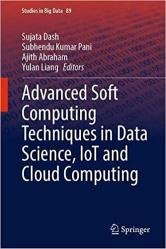Advanced Soft Computing Techniques in Data Science, IoT and Cloud Computing
- Добавил: literator
- Дата: 11-11-2021, 16:35
- Комментариев: 0
 Название: Advanced Soft Computing Techniques in Data Science, IoT and Cloud Computing
Название: Advanced Soft Computing Techniques in Data Science, IoT and Cloud ComputingАвтор: Sujata Dash, Subhendu K. Pani
Издательство: Springer
Серия: Studies in Big Data
Год: 2021
Страниц: 443
Язык: английский
Формат: pdf (true)
Размер: 12.5 MB
The new applications of soft computing can be regarded as an emerging field in computer science, automatic control engineering, medicine, biology application, natural environmental engineering, and pattern recognition. Now the exemplar model for soft computing is the human brain. The use of various techniques of soft computing is nowadays successfully implemented in many domestic, commercial, and industrial applications due to the low-cost and very high-performance digital processors and also the declining price of the memory chips. This is the main reason behind the wider expansion of soft computing techniques and their application areas.
These computing methods also play a significant role in the design and optimization of diverse engineering disciplines. With the influence and the development of the Internet of Things (IoT) concept, the need for using soft computing techniques has become more significant than ever. In general, soft computing methods are similar to biological processes very closely than traditional techniques, which are mostly based on formal logical systems, such as sentential logic and predicate logic, or rely heavily on computer-aided numerical analysis. Soft computing techniques are anticipated to complement each other. The aim of these techniques is to accept imprecision, uncertainties, and approximations to get a rapid solution.
However, recent advancements in representation soft computing algorithms (fuzzy logic, evolutionary computation, Machine Learning, and probabilistic reasoning) generate a more intelligent and robust system providing a human interpretable, low-cost, approximate solution. Soft computing-based algorithms have demonstrated great performance to a variety of areas including multimedia retrieval, fault tolerance, system modelling, network architecture, Web semantics, big data analytics, time series, biomedical and health informatics, etc. Soft computing approaches such as genetic programming (GP), support vector machine–firefly algorithm (SVM-FFA), artificial neural network (ANN), and support vector machine–wavelet (SVM–Wavelet) have emerged as powerful computational models. These have also shown significant success in dealing with massive data analysis for large number of applications.
All the researchers and practitioners will be highly benefited those who are working in field of computer engineering, medicine, biology application, signal processing, and mechanical engineering. This book is a good collection of state-of-the-art approaches for soft computing-based applications to various engineering fields. It is very beneficial for the new researchers and practitioners working in the field to quickly know the best performing methods. They would be able to compare different approaches and can carry forward their research in the most important area of research which has direct impact on betterment of the human life and health.
This book is very useful because there is no book in the market which provides a good collection of state-of-the-art methods of soft computing-based models for multimedia retrieval, fault tolerance, system modelling, network architecture, Web semantics, Big data analytics, time series, and biomedical and health informatics.
The book comprises the following three parts:
- Soft Computing Techniques for Internet of Things (IoT) devices
- Soft Computing Techniques in Cloud Computing and Computer Networking
- Soft Computing Techniques in Data Science
Скачать Advanced Soft Computing Techniques in Data Science, IoT and Cloud Computing
[related-news] [/related-news]
Внимание
Уважаемый посетитель, Вы зашли на сайт как незарегистрированный пользователь.
Мы рекомендуем Вам зарегистрироваться либо войти на сайт под своим именем.
Уважаемый посетитель, Вы зашли на сайт как незарегистрированный пользователь.
Мы рекомендуем Вам зарегистрироваться либо войти на сайт под своим именем.
